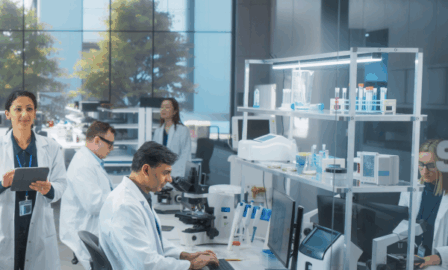2023 Laboratory Trends
Read our updated trends report here: 2024 Laboratory Trends
Clarkston’s team of life sciences consultants have highlighted the top laboratory trends that businesses should consider. Read all five trends for 2023 by downloading the full report here.
In recent years, many factors have contributed to the need for innovation in the laboratory space, most notably the COVID-19 pandemic. Streamlining laboratory processes has become essential, and technological advancements have made these types of upgrades a reality.
As we move into 2023, we expect to see the five following trends make a significant impact on progress in the laboratory industry sector: mobile LIMS adoption, data and analytics investment, real estate expansion, Artificial Intelligence (AI) automation, and supply chain disruption.
2023 Laboratory Trends
Trend #1: Mobile LIMS Allows for Curation out in the Field
Many companies use LIMS (laboratory information management systems) to help maintain data electronically. Traditionally, laboratories follow the typical experience where data for every sample has to be recorded manually at the testing site and then transferred to the stationary, primary LIMS back in the office. This process is prone to error, as the data has to be transcribed from notebooks to LIMS. Recently, we’ve begun to see companies starting to use mobile devices, such as tablets, phones, and scanners, which allow for the real-time recording of sample data at all stages. Utilizing mobile LIMS prevents transcription errors and can also reduce profit loss due to error investigations.
Another benefit of mobile LIMS is that it makes sample tracking much more manageable. The technician can follow the sample at each stage in the experiment all the way to the finished product, right from their mobile device. It allows access to laboratory data sooner than it has ever been available before and enables faster recognition of trends and decision-making based on results.
Trend #2: Data and Analytics Create Key Insights Into Clientele Base
It’s estimated that laboratories perform and interpret an average of 27 million tests per day – a significant amount of data. Data and analytics teams are essential for any company to provide key insights for better decision-making, more efficient processes, and faster innovation cycles. For the laboratory industry, that data can provide insight into how to innovate or adjust to meet the needs of the consumer, ultimately leading to quicker innovation cycles, which is key in such a competitive sector.
Data and analytics software investments will ensure laboratories are able to analyze test results quickly and compare data references in easy-to-synthesize formats. Strong data and analytics capabilities also enable laboratory teams to produce more efficient research and development. Researchers can use clinical results as a baseline that can then be compared to the different demographics of patients who eventually will use a product. Analytics tools make it easier to identify if something reacts in a patient differently depending on various circumstances that can be presented to the researcher all at once. This allows the researcher to know if having a pre-existing condition, for example, can influence the effectiveness of the therapy for the patient.
Analytic tools are also now being used to create individual treatment plans for patients. These tools can compare complex genomes and molecular structures to reference content sites in a matter of minutes. This information can then be placed in a report from which it is easier to draw conclusions for a more accurate diagnosis. Further, laboratories are also using analytic tools to predict staffing workloads. By using software to automate the process, laboratory managers can quickly determine staffing needs by location, time of day, types of tests performed, and/or by priority. Continue reading by downloading the full report below.
Download the Full 2023 Laboratory Trends Report Here
Subscribe to Clarkston's Insights
Contributions from Tamaria Reed



